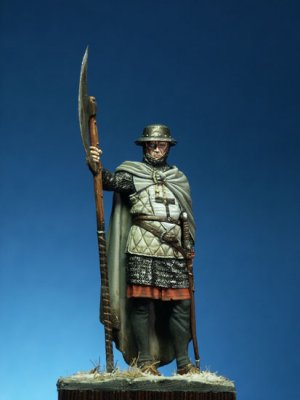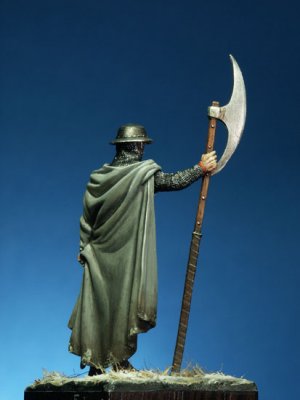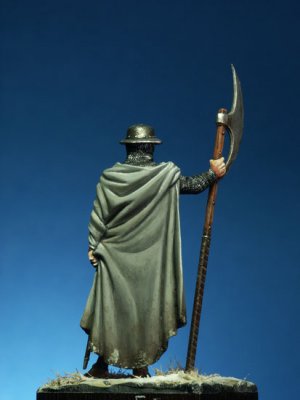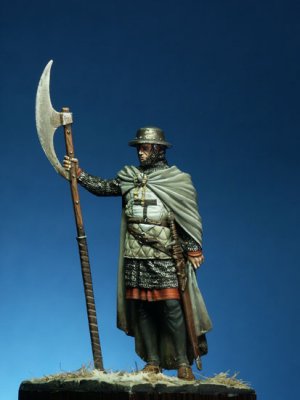







Ref.: ROME-54083

Sergeant of the Teutonic Order The sergeants (from the Latin “serventes”) in the feudal armies and, consequently, in those of the Monastic-Orders, were armed men whose duties were totally different from the known duties of a sergeant or a warrant Officer in a modern army. In the feudal army the sergeant was not intended in the chain of command as a liaison officer between the Commanding officers and the troops, and was not a squire at the service of a Knight as the Latin term might induce one to believe. He was instead a fighter on foot or mounted, whose social level was inferior to that of the Knightly Nobility, therefore he was a Bourgeois or a town inhabitant or a Country man subject to control of the Order. As a man-at-arms he was equipped with lighter and older weapons than those of the Brother Knights, but superior to those of the simple infantry man, he was also different from a squire due to the fact that he was not of Noble Origins destined to be educated to become a Knight. He was a sergeant and could rise no higher. Obviously this typology of man at arms was also present in other Monastic Orders such as Hospitallers and Templars. In the XII century one rule of the Templars established that the sergeants should wear a coat of mail without sleeves and gloves, as well as the substitution of the helmet with an iron hat. The sergeants were not obliged to fight for a long time in a battle because they were not armed as a Knight would be. The Rule established that they would receive the gratitude of God and of the Order if they fought well. They could withdraw from the battle without the need to ask for permission if they had been wounded, or realised they could not in any way continue, and they would not suffer any punishment. This Rule applied only to those armed with light weapons. Sergeants equipped as Knights were expected to fight like Knights would do. Up to the end of the XII century sergeants could not distinguish themselves through heraldic symbols, after the XII century they started to adopt the heraldry of the Order they belonged to, or the feudal army, or their Lord. A picture "Carmen de Rebus Siculis" by Pietro da Eboli dating back to the end of the XII century shows a group of mounted men-at-arms all with the same symbols on their shields. Painting instructions: Iron hat and coat of mail. Gambeson in natural leather or both natural or coloured material. The chest shows a black Tau (a T cross) on a white background. The mantle is woollen - any colour as long as natural and not brilliant, as the cost would be prohibitive for a sergeant; what must be avoided at all cost is the "Clauasa Cloak" of the Brother Knights. Under the iron coat of mail the figurine wears a coarse canvas shirt or coloured with natural dyes. Breeches are in coloured wool. Shoes, belt and the sheath of the sword are in natural leather. The hilt-guard of the sword and the pommel in iron. The weapon is wooden with a steel blade and natural leather handle.